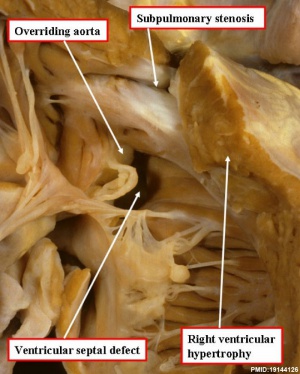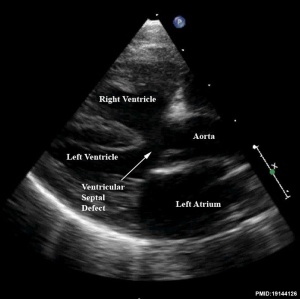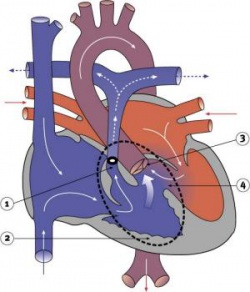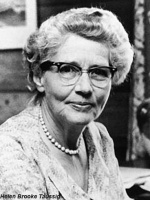Cardiovascular System - Tetralogy of Fallot: Difference between revisions
mNo edit summary |
mNo edit summary |
||
| Line 67: | Line 67: | ||
"Taussig used fluoroscopy, a new x-ray technique, to establish that babies suffering from anoxemia had a leaking septum (the wall that separates the chambers of the heart), and an underdeveloped artery leading from the heart to the lungs. In 1941 Taussig suggested an idea for an operation that might help children with "blue baby" to her colleagues at Hopkins—surgeon Alfred Blalock and surgical technician Vivien Thomas. On November 9, 1944 Taussig and Blalock first performed this new operation on a child with anoxemia, (after Thomas had experimented extensively with the procedure). They later repeated it successfully on two more patients. They published their results in the Journal of the American Medical Association. The technique was named the Blalock-Taussig operation, and was soon used worldwide. Taussig continued her research on cardiac birth defects and published her important work Congenital Malformations of the Heart, in 1947." (excerpt from [https://www.nlm.nih.gov/changingthefaceofmedicine/physicians/biography_316.html NLM biography]) | "Taussig used fluoroscopy, a new x-ray technique, to establish that babies suffering from anoxemia had a leaking septum (the wall that separates the chambers of the heart), and an underdeveloped artery leading from the heart to the lungs. In 1941 Taussig suggested an idea for an operation that might help children with "blue baby" to her colleagues at Hopkins—surgeon Alfred Blalock and surgical technician Vivien Thomas. On November 9, 1944 Taussig and Blalock first performed this new operation on a child with anoxemia, (after Thomas had experimented extensively with the procedure). They later repeated it successfully on two more patients. They published their results in the Journal of the American Medical Association. The technique was named the Blalock-Taussig operation, and was soon used worldwide. Taussig continued her research on cardiac birth defects and published her important work Congenital Malformations of the Heart, in 1947." (excerpt from [https://www.nlm.nih.gov/changingthefaceofmedicine/physicians/biography_316.html NLM biography]) | ||
:'''Search PubMed:''' [http://www.ncbi.nlm.nih.gov/pubmed/?term=TAUSSIG%20HB%5BAuthor%5D&cauthor=true&cauthor_uid=18934387 Taussig HB (Author)] | |||
Revision as of 11:24, 5 April 2016
| Embryology - 18 Apr 2024 |
|---|
| Google Translate - select your language from the list shown below (this will open a new external page) |
|
العربية | català | 中文 | 中國傳統的 | français | Deutsche | עִברִית | हिंदी | bahasa Indonesia | italiano | 日本語 | 한국어 | မြန်မာ | Pilipino | Polskie | português | ਪੰਜਾਬੀ ਦੇ | Română | русский | Español | Swahili | Svensk | ไทย | Türkçe | اردو | ייִדיש | Tiếng Việt These external translations are automated and may not be accurate. (More? About Translations) |
Introduction
Named after Etienne-Louis Arthur Fallot (1888) who described it as "la maladie blue" and is a common developmental cardiac defect. The syndrome consists of a number of a number of cardiac defects possibly stemming from abnormal neural crest migration. Tetralogy refers to a set of four related symptoms or abnormalities frequently occurring together.
ICD-10 Q21.3 Tetralogy of Fallot Ventricular septal defect with pulmonary stenosis or atresia, dextroposition of aorta and hypertrophy of right ventricle.
This cardiovascular abnormality has also been researched as a 2011 Student Project.
Some Recent Findings
* Genome-wide association study identifies loci on 12q24 and 13q32 associated with Tetralogy of Fallot[1] "We conducted a genome-wide association study to search for risk alleles associated with Tetralogy of Fallot (TOF), using a northern European discovery set of 835 cases and 5159 controls. A region on chromosome 12q24 was associated (P = 1.4 × 10(-7)) and replicated convincingly (P = 3.9 × 10(-5)) in 798 cases and 2931 controls [per allele odds ratio (OR) = 1.27 in replication cohort, P = 7.7 × 10(-11) in combined populations]. Single nucleotide polymorphisms in the glypican 5 gene on chromosome 13q32 were also associated (P = 1.7 × 10(-7)) and replicated convincingly (P = 1.2 × 10(-5)) in 789 cases and 2927 controls (per allele OR = 1.31 in replication cohort, P = 3.03 × 10(-11) in combined populations). Four additional regions on chromosomes 10, 15 and 16 showed suggestive association accompanied by nominal replication. This study, the first genome-wide association study of a congenital heart malformation phenotype, provides evidence that common genetic variation influences the risk of TOF."
|
| More recent papers |
|---|
|
This table allows an automated computer search of the external PubMed database using the listed "Search term" text link.
More? References | Discussion Page | Journal Searches | 2019 References | 2020 References Search term: Tetralogy of Fallot <pubmed limit=5>Tetralogy of Fallot</pubmed> |
International Classification of Diseases
Congenital malformations of the circulatory system
Q21 Congenital malformations of cardiac septa
Excl.: acquired cardiac septal defect (I51.0)
- Q21.0 Ventricular septal defect
- Q21.1 Atrial septal defect Coronary sinus defect Patent or persistent: foramen ovale ostium secundum defect (type II) Sinus venosus defect
- Q21.2 Atrioventricular septal defect Common atrioventricular canal Endocardial cushion defect Ostium primum atrial septal defect (type I)
- Q21.3 Tetralogy of Fallot Ventricular septal defect with pulmonary stenosis or atresia, dextroposition of aorta and hypertrophy of right ventricle.
- Q21.4 Aortopulmonary septal defect Aortic septal defect Aortopulmonary window
- Q21.8 Other congenital malformations of cardiac septa Eisenmenger's defect Pentalogy of Fallot Excl.: Eisenmenger's complex (I27.8) syndrome (I27.8)
- Q21.9 Congenital malformation of cardiac septum, unspecified Septal (heart) defect NOS
Abnormality Features
Occurs in about 3 in 10,000 live births and causes 7–10% of all congenital cardiac malformations.
- ventricular septal defect
- obstruction of the right ventricular outflow tract
- override of the ventricular septum by the aortic root
- right ventricular hypertrophy.

|

|
| Autopsy showing features of Tetralogy of Fallot[3] | Tetralogy of Fallot Echocardiography[3] |
People
| valign=top|Dr Helen Brooke Taussig (1898-1986) was a paediatric cardiologist, who developed a surgical procedure for Tetralogy of Fallot.[4] She also campaigned for blocking introduction of thalidomide into the U.S.A. One of her students had drawn her attention to the data on congenital malformations occurring in Germany and England.
"Taussig used fluoroscopy, a new x-ray technique, to establish that babies suffering from anoxemia had a leaking septum (the wall that separates the chambers of the heart), and an underdeveloped artery leading from the heart to the lungs. In 1941 Taussig suggested an idea for an operation that might help children with "blue baby" to her colleagues at Hopkins—surgeon Alfred Blalock and surgical technician Vivien Thomas. On November 9, 1944 Taussig and Blalock first performed this new operation on a child with anoxemia, (after Thomas had experimented extensively with the procedure). They later repeated it successfully on two more patients. They published their results in the Journal of the American Medical Association. The technique was named the Blalock-Taussig operation, and was soon used worldwide. Taussig continued her research on cardiac birth defects and published her important work Congenital Malformations of the Heart, in 1947." (excerpt from NLM biography)
- Search PubMed: Taussig HB (Author)
References
Reviews
<pubmed></pubmed> <pubmed>22723533</pubmed> <pubmed>22344815</pubmed> <pubmed>21916347</pubmed> <pubmed>20091166</pubmed> <pubmed>19144126</pubmed> <pubmed>15016061</pubmed>
Articles
<pubmed></pubmed> <pubmed>26471818</pubmed> <pubmed>23323122</pubmed> <pubmed>21208432</pubmed>
Search Pubmed
Search Pubmed: Tetralogy of Fallot
Search OMIM: Tetralogy of Fallot
External Links
External Links Notice - The dynamic nature of the internet may mean that some of these listed links may no longer function. If the link no longer works search the web with the link text or name. Links to any external commercial sites are provided for information purposes only and should never be considered an endorsement. UNSW Embryology is provided as an educational resource with no clinical information or commercial affiliation.
- OMIM Tetralogy of Fallot
- PubMed Health TOF
- NIH What Is Tetralogy of Fallot?
- The Royal Children's Hospital Melbourne Fallots Tetralogy
Glossary Links
- Glossary: A | B | C | D | E | F | G | H | I | J | K | L | M | N | O | P | Q | R | S | T | U | V | W | X | Y | Z | Numbers | Symbols | Term Link
Cite this page: Hill, M.A. (2024, April 18) Embryology Cardiovascular System - Tetralogy of Fallot. Retrieved from https://embryology.med.unsw.edu.au/embryology/index.php/Cardiovascular_System_-_Tetralogy_of_Fallot
- © Dr Mark Hill 2024, UNSW Embryology ISBN: 978 0 7334 2609 4 - UNSW CRICOS Provider Code No. 00098G



